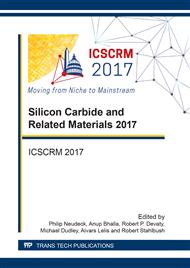[1]
M. Östling, Silicon Carbide Based Power Devices,, in IEEE Electron Devices Meeting (IEDM), p.13.3.1-13.3.4, (2010).
Google Scholar
[2]
T. Kimoto and J. A. Cooper, Fundamentals of Silicon Carbide Technology: Growth, Characterization, Devices, and Applications. John Wiley & Sons, (2014).
Google Scholar
[3]
H. Niwa, J. Suda, and T. Kimoto, 21.7 kV 4H-SiC PiN diode with a Space-Modulated Junction Termination Extension,, Appl. Phys. Express, vol. 5, no. 6, p.4–6, (2012).
DOI: 10.1143/apex.5.064001
Google Scholar
[4]
J. W. Palmour, Silicon carbide power device development for industrial markets,, in IEEE Electron Devices Meeting (IEDM), p.1.1.1-1.1.8, (2014).
DOI: 10.1109/iedm.2014.7046960
Google Scholar
[5]
A. Salemi et al., Conductivity modulated on-axis 4H-SiC 10+ kV PiN diodes,, Proc. Int. Symp. Power Semicond. Devices ICs (ISPSD), vol. 2015–June, p.269–272, (2015).
DOI: 10.1109/ispsd.2015.7123441
Google Scholar
[6]
R. Ghandi, B. Buono, M. Domeij, G. Malm, C.-M. Zetterling, and M. Östling, High-Voltage 4H-SiC PiN Diodes With Etched Junction Termination Extension,, IEEE Electron Device Lett., vol. 30, no. 11, p.1170–1172, Nov. (2009).
DOI: 10.1109/led.2009.2030374
Google Scholar
[7]
G. Pâques, S. Scharnholz, N. Dheilly, D. Planson, and R. W. De Doncker, High-Voltage 4H-SiC Thyristors With a Graded Etched Junction Termination Extension,, IEEE Electron Device Lett., vol. 32, no. 10, p.1421–1423, (2011).
DOI: 10.1109/led.2011.2163055
Google Scholar
[8]
H. Elahipanah, A. Salemi, C.-M. Zetterling, and M. Östling, Modification of Etched Junction Termination Extension for the High Voltage 4H-SiC Power Devices,, Mater. Sci. Forum, vol. 858, p.4–5, (2016).
DOI: 10.4028/www.scientific.net/msf.858.978
Google Scholar
[9]
A. Salemi, H. Elahipanah, G. Malm, C.-M. Zetterling, and M. Östling, Area- and efficiency-optimized junction termination for a 5.6 kV SiC BJT process with low ON-resistance,, Proc. Int. Symp. Power Semicond. Devices ICs (ISPSD), p.249–252, (2015).
DOI: 10.1109/ispsd.2015.7123436
Google Scholar
[10]
L. Lanni, B. G. Malm, M. Östling, and C.-M. Zetterling, SiC etching and sacrificial oxidation effects on the performance of 4H-SiC BJTs,, Mater. Sci. Forum, vol. 778, p.1005–1008, (2014).
DOI: 10.4028/www.scientific.net/msf.778-780.1005
Google Scholar
[11]
A. Salemi, H. Elahipanah, C.-M. Zetterling, and M. Östling, Investigation of the Breakdown Voltage in High Voltage 4H-SiC BJT with Respect to Oxide and Interface Charges,, Mater. Sci. Forum, vol. 821–823, p.834–837, (2015).
DOI: 10.4028/www.scientific.net/msf.821-823.834
Google Scholar
[12]
L. Lanni, B. G. Malm, M. Östling, and C.-M. Zetterling, Influence of Passivation Oxide Thickness and Device Layout on the Current Gain of SiC BJTs,, IEEE Electron Device Lett., vol. 36, no. 1, p.11–13, (2015).
DOI: 10.1109/led.2014.2372036
Google Scholar
[13]
A. O. Konstantinov, Q. Wahab, N. Nordell, and U. Lindefelt, Ionization Rates and Critical Fields in 4H SiC Junction Devices,, Mater. Sci. Forum, vol. 264–268, no. March, p.513–516, (1998).
DOI: 10.4028/www.scientific.net/msf.264-268.513
Google Scholar


